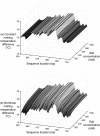Shared probe design and existing microarray reanalysis using PICKY
- PMID: 20406469
- PMCID: PMC2875240
- DOI: 10.1186/1471-2105-11-196
Shared probe design and existing microarray reanalysis using PICKY
Abstract
Background: Large genomes contain families of highly similar genes that cannot be individually identified by microarray probes. This limitation is due to thermodynamic restrictions and cannot be resolved by any computational method. Since gene annotations are updated more frequently than microarrays, another common issue facing microarray users is that existing microarrays must be routinely reanalyzed to determine probes that are still useful with respect to the updated annotations.
Results: PICKY 2.0 can design shared probes for sets of genes that cannot be individually identified using unique probes. PICKY 2.0 uses novel algorithms to track sharable regions among genes and to strictly distinguish them from other highly similar but nontarget regions during thermodynamic comparisons. Therefore, PICKY does not sacrifice the quality of shared probes when choosing them. The latest PICKY 2.1 includes the new capability to reanalyze existing microarray probes against updated gene sets to determine probes that are still valid to use. In addition, more precise nonlinear salt effect estimates and other improvements are added, making PICKY 2.1 more versatile to microarray users.
Conclusions: Shared probes allow expressed gene family members to be detected; this capability is generally more desirable than not knowing anything about these genes. Shared probes also enable the design of cross-genome microarrays, which facilitate multiple species identification in environmental samples. The new nonlinear salt effect calculation significantly increases the precision of probes at a lower buffer salt concentration, and the probe reanalysis function improves existing microarray result interpretations.
Figures






Similar articles
-
Direct calibration of PICKY-designed microarrays.BMC Bioinformatics. 2009 Oct 23;10:347. doi: 10.1186/1471-2105-10-347. BMC Bioinformatics. 2009. PMID: 19849862 Free PMC article.
-
Thermodynamically optimal whole-genome tiling microarray design and validation.BMC Res Notes. 2016 Jun 13;9:305. doi: 10.1186/s13104-016-2113-4. BMC Res Notes. 2016. PMID: 27295952 Free PMC article.
-
Picky: oligo microarray design for large genomes.Bioinformatics. 2004 Nov 22;20(17):2893-902. doi: 10.1093/bioinformatics/bth347. Epub 2004 Jun 4. Bioinformatics. 2004. PMID: 15180932
-
Efficient oligonucleotide probe selection for pan-genomic tiling arrays.BMC Bioinformatics. 2009 Sep 16;10:293. doi: 10.1186/1471-2105-10-293. BMC Bioinformatics. 2009. PMID: 19758451 Free PMC article.
-
[Research progress of probe design software of oligonucleotide microarrays].Sheng Wu Yi Xue Gong Cheng Xue Za Zhi. 2014 Feb;31(1):214-21. Sheng Wu Yi Xue Gong Cheng Xue Za Zhi. 2014. PMID: 24804514 Review. Chinese.
Cited by
-
Expanding probe repertoire and improving reproducibility in human genomic hybridization.Nucleic Acids Res. 2013 Apr;41(7):e81. doi: 10.1093/nar/gkt048. Epub 2013 Feb 1. Nucleic Acids Res. 2013. PMID: 23376933 Free PMC article.
-
Preparation of long single-strand DNA concatemers for high-level fluorescence in situ hybridization.Commun Biol. 2021 Oct 25;4(1):1224. doi: 10.1038/s42003-021-02762-2. Commun Biol. 2021. PMID: 34697406 Free PMC article.
-
Two mechanisms repress cyclin B1 translation to maintain prophase arrest in mouse oocytes.Nat Commun. 2024 Nov 20;15(1):10044. doi: 10.1038/s41467-024-54161-w. Nat Commun. 2024. PMID: 39567493 Free PMC article.
-
Rational Design of High-Number dsDNA Fragments Based on Thermodynamics for the Construction of Full-Length Genes in a Single Reaction.PLoS One. 2015 Dec 30;10(12):e0145682. doi: 10.1371/journal.pone.0145682. eCollection 2015. PLoS One. 2015. PMID: 26716828 Free PMC article.
-
Whole-genome thermodynamic analysis reduces siRNA off-target effects.PLoS One. 2013;8(3):e58326. doi: 10.1371/journal.pone.0058326. Epub 2013 Mar 6. PLoS One. 2013. PMID: 23484018 Free PMC article.
References
-
- Coblentz FE, Towle DW, Shafer TH. Expressed sequence tags from normalized cDNA libraries prepared from gill and hypodermal tissues of the blue crab, Callinectes sapidus. Comparative Biochemistry And Physiology D-Genomics & Proteomics. 2006;1:200–208. - PubMed
Publication types
MeSH terms
Substances
LinkOut - more resources
Full Text Sources
Other Literature Sources

